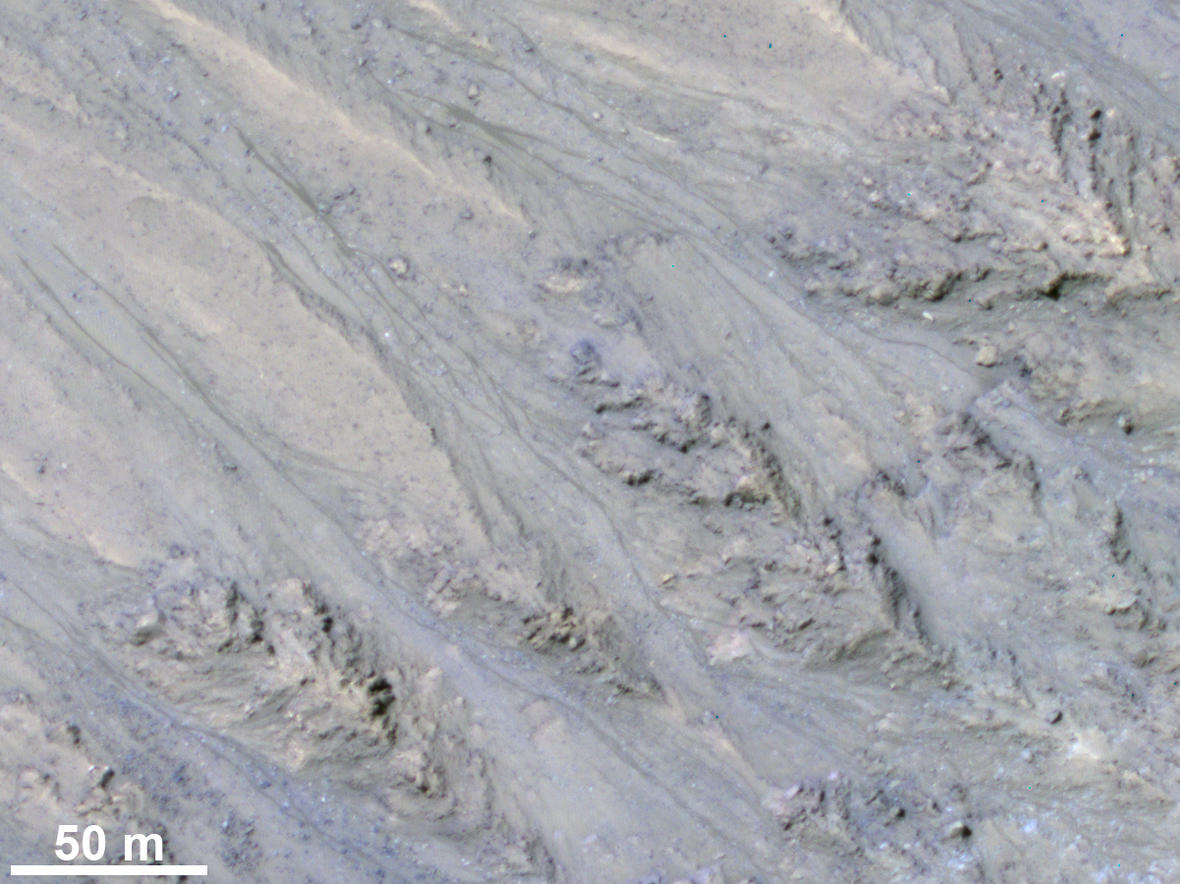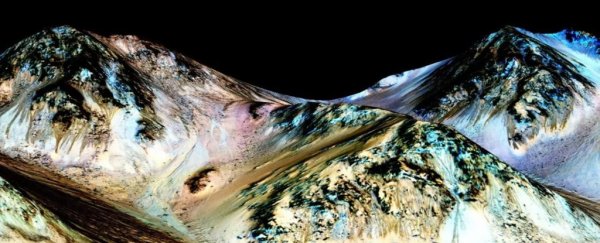In 2015, NASA announced that it had "the best evidence yet" for water flowing on the surface of Mars: Dark, apparently damp streaks spotted on the Red Planet contained salts associated with liquid water.
The news had NASA's head of planetary science, Jim Green, imagining future astronauts slurping up the salty sludge as they explored the Red Planet.
"Mark Watney could have taken advantage of this discovery," he told The Washington Post at the time, referring to the central character of the movie The Martian.
Others suggested that the streaks might harbor microbial life.
But then US Geological Survey scientists decided to take a look. In a study published Monday in the journal Nature Geoscience, the USGS says that those promising streaks are merely marks made by flowing sand or dust.
 Recurring slope lineae up close (NASA/JPL/University of Arizona/USGS. Public domain)
Recurring slope lineae up close (NASA/JPL/University of Arizona/USGS. Public domain)
"This new understanding … supports other evidence that shows that Mars today is very dry," lead author Colin Dundas said in a news release.
The finding is the latest disappointment for scientists who hoped that the streaks, technically called "recurring slope lineae," might indicate that Mars isn't quite the desolate desert wasteland it's commonly made out to be.
While the RSL weren't ever direct evidence of water, they seemed like a strong indicator.
Scientists had noticed that the streaks grew and shrank in response to the seasons - almost as if salty water was being heated by the Sun and then flowing down ridges and hills.
Not only that, but the streaks contained perchlorates - molecules that help water stay liquid over a broader range of temperatures.
But when Dundas and his colleagues examined images of dozens of RSL at multiple sites, they found the "streaks" didn't behave like flowing water.
For one thing, they existed only at the tops of very steep slopes. For another, the streaks all seemed to end when their slopes matched the dynamic "angle of repose" - the steepest angle at which a given material can be piled without slumping.
If you've ever tried to build a sand castle, you're familiar with this concept. It's why dry sand - which has a very shallow angle of repose - tends to slide out of shape, but wet sand - with a steeper angle of repose - can be piled into towers and turrets.
"The RSL don't flow onto shallower slopes, and the lengths of these are so closely correlated with the dynamic angle of repose, it can't be a coincidence," co-author Alfred McEwen of the University of Arizona, Tucson, told Phys.org.
McEwen is the principle investigator for HiRISE, a camera on the Mars Reconnaissance Orbiter that was used to image the RSLs.
The RSL aren't created by water, Dundas and McEwen concluded. Instead, they resemble the markings left by dry grains that slide down the sides of a sad, slumping sand castle.
This doesn't mean there's no water whatsoever in the RSL, they write. The tendency for these streaks to appear in warm seasons, along with the presence of perchlorates, suggest that water might help the streaks form.
"However, liquid water volumes may be small or zero," the authors say.
That fits with a study published last year in the journal Geophysical Research Letters that found the streaks could contain no more than 3 percent liquid water - making them little more than mildly damp, slightly salty dirt.
Mars's weird streaks probably couldn't keep an astronaut alive, and they probably aren't home to tiny alien organisms. But they're still worth studying, McEwen said.
"RSL probably form by some mechanism that is unique to the environment of Mars," he told Phys.org, "so they represent an opportunity to learn about how Mars behaves, which is important for future surface exploration."
2017 © The Washington Post
This article was originally published by The Washington Post.
